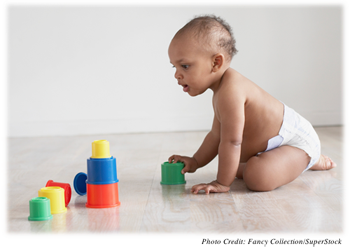

Chapter 1. Brain Development: Infants and Toddlers
Synopsis
Brain Development: Infants and Toddlers
Author

S. Stavros Valenti, Hofstra University
Synopsis
In this activity, you will observe animated illustrations of brain development from birth to age 2. A microscopic view will highlight the formation of myelin on the connecting fibers (axons) of neurons. A macroscopic view will show the brain growing in step with the enlargement of the infant’s head.
REFERENCES
Kolb, B., & Whishaw, I. Q. (2001). An introduction to brain and behavior. NY: Worth Publishers.
At Birth: The Brain Isn't Finished!

Most of a newborn’s organs are relatively immature at birth. For example, babies cannot digest solid food, and they have no control over either their bowels or their bladders. The brain, in particular, is quite immature at birth, and this is reflected in a newborn’s short waking periods, poor eyesight, and limited control of posture and movement.
There is good evidence that, indeed, “babies are born fetuses”! Compared to our closest primate species, we have less overall capacity at birth to act voluntarily (e.g., cling to mother); our bones are less developed; and the networks of brain cells (neurons) are still developing rapidly. In this sense, we are all born “premature.”
Most scientists believe that as our species developed a larger and more complex brain, childbirth had to occur before our brain could fully form. If the prenatal period was extended, the baby’s head would have been too large to pass safely out of the mother’s body at birth.
Rapid Brain Growth in Infancy

At birth, a baby’s brain has already attained 25 percent of its adult weight. In contrast, a baby’s body weight is only 5 percent of its adult weight, so the newborn’s brain is proportionally five times more developed than its body in terms of weight at birth.
This rapid brain growth continues. The first two years, like the prenatal period, is a time of tremendous brain growth. By age two, the baby’s brain has achieved 75 percent of its adult weight! The rest of the body also grows quickly, and it achieves 20 percent of its adult weight in the same amount of time.
Microscopic Changes: An Explosion of Connections

Most of the increase in brain weight over the first two years is due to transient exuberance, a proliferation of dendrites in the cortex. Remember, dendrites receive signals from connecting neurons across tiny gaps called the synapses. Dendrites show a fivefold increase in the first two years with as many as 15,000 new connections for each neuron.
The vast neural networks created by the rapid growth of dendrites allow more flexible processing of information. As a result of maturation and experience, some of these connections will be lost due to synaptic pruning, or remolding, as the brain becomes more finely tuned.
Microscopic Changes: Myelination of Connections Within the Brain

Another aspect of brain maturation is the development of myelin, the insulation that forms on the long outgoing axons of neurons. Myelin prevents neighboring cells from short-circuiting each other’s activity, and it speeds up the transmission of signals.
The process of myelination begins in the prenatal period and is largely completed by age three. However, the prefrontal cortex, the brain region most important for focused attention and goal setting, develops at a slower pace through childhood, adolescence, and even into the late 20s!
Play the animation and watch the sequence in the process of myelination.
Summary

Brain development continues at a rapid pace in the first two years. The brain reaches nearly 75 percent of its adult weight, and there are far more connections than will be present later on—leaving much room for “remolding” of the brain’s connections in the years to come. While many areas of the cortex have matured through myelination, the areas most important for complex thinking (e.g., focused attention and goal-setting) will not function optimally until adolescence and the mid 20s.
View the animation to review brain development in infants and toddlers up to two years old. The animation demonstrates brain growth in step with the head and the process of myelination, which continues up into the early 20s.
Assessment: Check Your Understanding

1.
1. At birth, the newborn's brain is fully developed.
Assessment: Check Your Understanding

2.
2. By age 2, transient exuberance is a main cause of increased:
Assessment: Check Your Understanding

3.
3. Myelin reduces transmission of neural signals and prevents neighboring cells from short-circuiting each other’s activity.
Assessment: Check Your Understanding

4.
4. In your own words, summarize the major brain development from birth to age two.
Congratulations! You have completed this activity.Total Score: x out of x points (x%) You have received a provisional score for your essay answers, which have been submitted to your instructor.